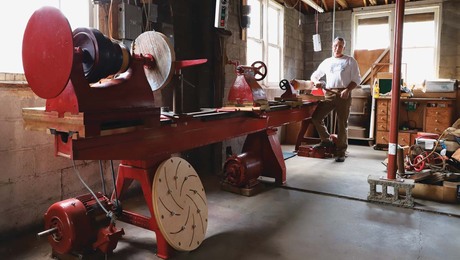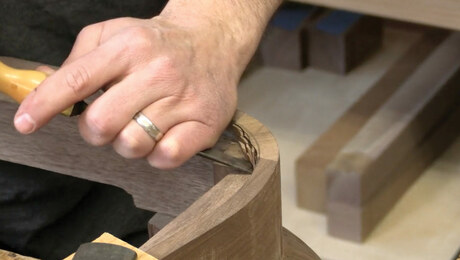German-style hand tools: Try them!
If you pick up a Primus plane and give it the run of your bench for a while, you’ll soon be compelled to discover what else you’ve been missing
I have been an enthusiastic reader of Fine Woodworking almost from the very beginning. These days I’m a subscriber who awaits every new issue’s arrival in the mailbox, but in my poverty-stricken youth I bought as many issues from the newsstand as I could afford.
For me, the hook of those early issues was Tage Frid. Here was a craftsman who had a similar background and training to mine: He served his apprenticeship in Denmark, while I served mine nearby in North Germany; his field was furniture making, mine was organ building. Frid wrote about using German-style hand tools such as wooden-body planes, frame saws, and bench chisels—the same ones I had learned to use. Even though my field diverged from his, I felt very much at home reading about his projects and design philosophy.
Despite Frid’s prominence at the magazine and his stated preference for German-style hand tools, I noticed from the start that Fine Woodworking was taking a different tack, almost exclusively emphasizing English-style metal-body handplanes and backsaws made by Stanley, Record, and others. Lately, with the increased fascination with Japanese tools, the magazine has been publishing articles about Japanese handplanes and handsaws. I admit that I’ve had my flirtations with Japanese tools, too. I find it unfortunate, however, that Fine Woodworking has given so little coverage to German hand tools, and especially to the reasons why many craftsmen find them preferable to English-style tools.
Not long ago, in the magazine’s review of 14 smoothing planes, 13 were metal-bodied planes in the mold of the Stanley/Record #4. The one outlier was the ECE Primus, an “improved” version (so-called because of its adjustment wheel) of the traditional wooden-bodied smoother of the sort used throughout continental Europe. The reviewer dismissed it, saying: “Glides easily on its slick lignum vitae sole, but light weight didn’t provide much inertia.” But that lightness is exactly the feature that appeals to European cabinetmakers. The plane’s relatively low mass and high center of gravity mean that one can maneuver it with greater ease than a metal-body plane weighing almost twice as much.
The lighter weight is especially important when, for example, one has to work at an angle or even on the underside of a piece, as I have done on many occasions. The reduced weight is also a godsend when smoothing large surfaces—the top of a table, perhaps, or, in my case, the soundboard of a harpsichord. The Primus smoother corners like a sportscar; it’s possible to grasp the plane lightly around the base (rather than by the hand grips), almost in the manner of a block plane, while doing delicate operations.
The squared sides of its body make it simple to clamp on a right-angle fence, allowing me to accurately trim and square up the edges of a workpiece. Similarly, with a wooden-bodied jointer plane, the square body clamps easily to the workbench for accurately shooting edges. And compare the ordeal of flattening the sole of a steel-bodied jointer plane with the five minutes it takes to true the sole of a wooden-bodied jointer.
The angle of the Primus smoother’s plane iron is another advantage. At 50° to the work surface, it is just 5° steeper than the angle on a standard metal-body smoothing plane, but it makes a world of difference when working end grain or highly figured wood.
There is much more to say in praise of German-style tools, from specialty planes to hammers and from workbenches to frame saws, but perhaps if you pick up a Primus plane and give it the run of your bench for a while, you’ll soon be compelled to discover what else you’ve been missing.
Christopher Brodersen builds historical keyboard instruments in Northville, Mich. (cbrodersen.com). Send your woodworking story to [email protected]; we’ll pay for any that we publish.
More on FineWoodworking.com:
- Get a Big Chisel for Little Work
- Vintage Woodworking Tools are Easy to Love
- Butt Chisel – These short-handled butt chisels feature rosewood handles and Sheffield steel blades
Fine Woodworking Recommended Products

Stanley Powerlock 16-ft. tape measure

Veritas Precision Square

Starrett 4" Double Square


























Comments
I picked up an "improved" Primus with a hornbeam sole almost by accident in a blind auctuon last week. Having never caught my attention prior, I was completely surprised by the intuitive feel of it once tuned. The range from light to heavy based on user pressure and technique feels like it has low "octaves" unachivable w heavier bodied metal planes. After waxing, w blade retracted, the plane skitters forward up to a foot over the wood surface w a light push of a finger. Count me as a new beliver. Even as a lefty using this non lignum soled, right handed unit. Not sure what the irons a forged from but they shrarpen easily, and seem to hold up as well as some of the A-2s i have. Doesn't seem to leave quite the waxy brilliance as my PMV-11 BU does, but damn close...
Keep it up!! Thanks for sharing
I own a Record and a L-N#4 planes, as well as the improved Primus smoother. I always prefer the Primus; I like the light weight and it allows me to know sooner if I am pushing a bad angle. I feel it gives me more sensitivity to the wood surface. It is less fatiguing for me as well. The adjustment mechanism involves a learning curve, but once learned is a non-issue. The manufacturer could improve the owner's manual. The Improved Primus is much easier to microadjust than the others.
Thank you, Christopher! This was a timely find for me, as I am just now setting up shop in the basement under our apartment here in Tallinn, Estonia.
I married into Estonia: I met my wife at music school in The Hague in 1996-1998. She was there to study baroque singing; I was there to study baroque trombone.
Our 14-year-old son just finished a seven-year stretch of harpsichord study at his semi-private school in Tallinn's medieval old town. Unfortunately he has decided to not continue with that, but at the moment he *is* enrolled in the same school's woodworking class. :-)
I have a fantasy that someday I'll build my own chamber organ--tuned to high pitch, A=460-466--that I can haul around in the back of our '92Volvo wagon. (Hey, a guy can dream, right?)
--George Butler
Log in or create an account to post a comment.
Sign up Log in